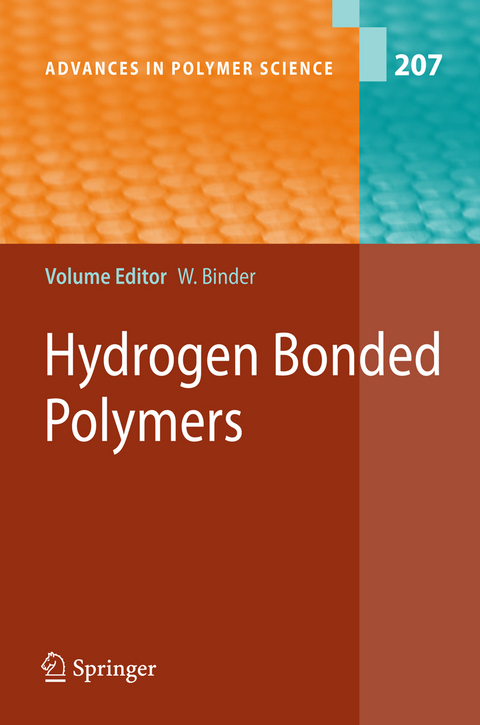
Hydrogen Bonded Polymers
Seiten
2007
Springer Berlin (Verlag)
978-3-540-68587-6 (ISBN)
Springer Berlin (Verlag)
978-3-540-68587-6 (ISBN)
Control of polymeric structure is among the most important endeavours of modern macromolecular science. In particular, tailoring the positioning and strength of intermolecular forces within macromolecules by synthetic me- odsandthusgaining structuralcontrolover the?nalpolymeric materials has become feasible, resulting in the ?eld of supramolecular polymer science. - sides other intermolecular forces, hydrogen bonds are unique intermolecular forces enabling the tuning of material properties via self-assembly processes 1 overawiderangeofinteractionstrengthrangingfromseveralkJmol tosev- 1 eraltensofkJmol . Centralfortheformationofthesestructuresareprecursor molecules of small molecular weight (usually lower than 10 000), which can assembleinsolidorsolutiontoaggregatesofde?nedgeometry. Intermolecular hydrogenbondsatde?nedpositionsofthesebuildingblocksaswellastheir- spectivestartinggeometryandtheinitialsizedeterminethemodeofassembly into supramolecular polymers forming network-, rodlike-, ?brous-, disclike- , helical-, lamellar- and chainlike architectures. In all cases, weak to strong hydrogen-bondinginteractionscanactasthecentralstructure-directingforce fortheorganizationofpolymerchainsandthusthe?nalmaterials properties. Theimportantcontributionofhydrogenbondstotheareaofsupramole- lar polymer chemistry is de?nitely outstanding, most of all since the potency of hydrogen-bonding systems has been found to be unique in relation to other supramolecular interactions. Thus the high level of structural diversity of many hydrogen-bonding systems as well as their high level of direction- ity and speci?city in recognition-phenomena is unbeaten in supramolecular chemistry. The realization, that their stability can be tuned over a wide range of binding strength is important for tuning the resulting material prop- ties, ranging from elastomeric to thermoplastic and even highly crosslinked duroplastic structures and networks. On the basis of the thermal reversib- ity, new materials with highly tunable properties can now be prepared, - ing able to change their mechanical and optoelectronic properties with very smallchangesofexternalstimuli. Thusthe?eldofhydrogen-bondedpolymers forms the basis for stimuli responsive and adaptable materials of the future.
Supramolecular Polymers and Networkswith Hydrogen Bonds in the Main- and Side-Chain.- Assembly via Hydrogen Bonds of Low Molar Mass Compounds into Supramolecular Polymers.- Supramolecular Materials Based On Hydrogen-Bonded Polymers.- Nanocomposites Based on Hydrogen Bonds.
| Erscheint lt. Verlag | 16.3.2007 |
|---|---|
| Reihe/Serie | Advances in Polymer Science |
| Co-Autor | W.H. Binder, L. Bouteiller, G. ten Brinke, O. Ikkala, V.M. Rotello, J. Ruokolainen, S. Srivastava, H. Xu, R. Zirbs |
| Zusatzinfo | XI, 206 p. With online files/update. |
| Verlagsort | Berlin |
| Sprache | englisch |
| Maße | 155 x 235 mm |
| Themenwelt | Naturwissenschaften ► Chemie ► Organische Chemie |
| Naturwissenschaften ► Physik / Astronomie ► Festkörperphysik | |
| Naturwissenschaften ► Physik / Astronomie ► Thermodynamik | |
| Technik ► Maschinenbau | |
| Schlagworte | Compound • Duroplaste • Elastomer • Nanocomposites • Polymer • polymer chemistry • Polymers • soft matter • Supramolecules • Thermoplast • Thermoset |
| ISBN-10 | 3-540-68587-1 / 3540685871 |
| ISBN-13 | 978-3-540-68587-6 / 9783540685876 |
| Zustand | Neuware |
| Informationen gemäß Produktsicherheitsverordnung (GPSR) | |
| Haben Sie eine Frage zum Produkt? |
Mehr entdecken
aus dem Bereich
aus dem Bereich


